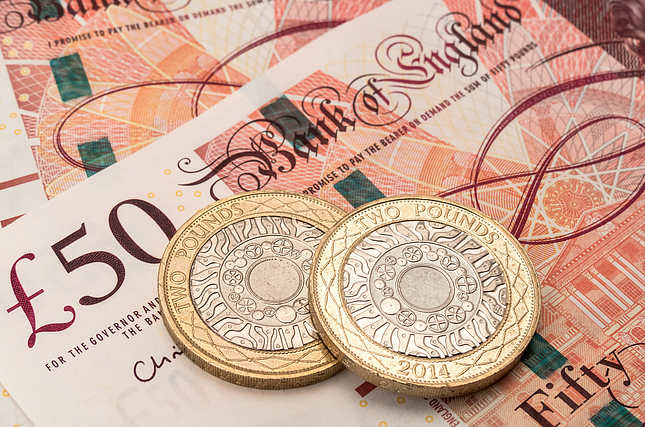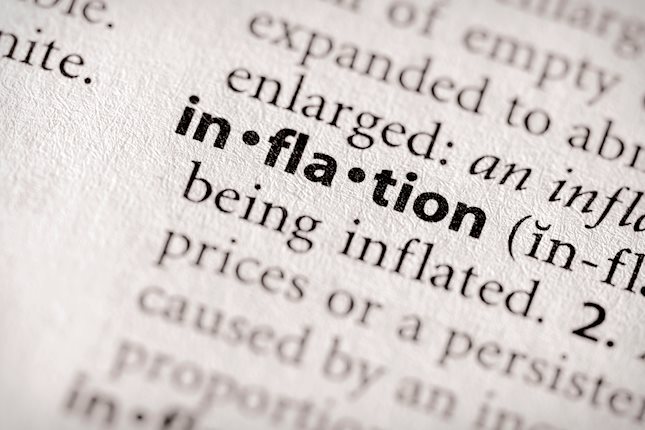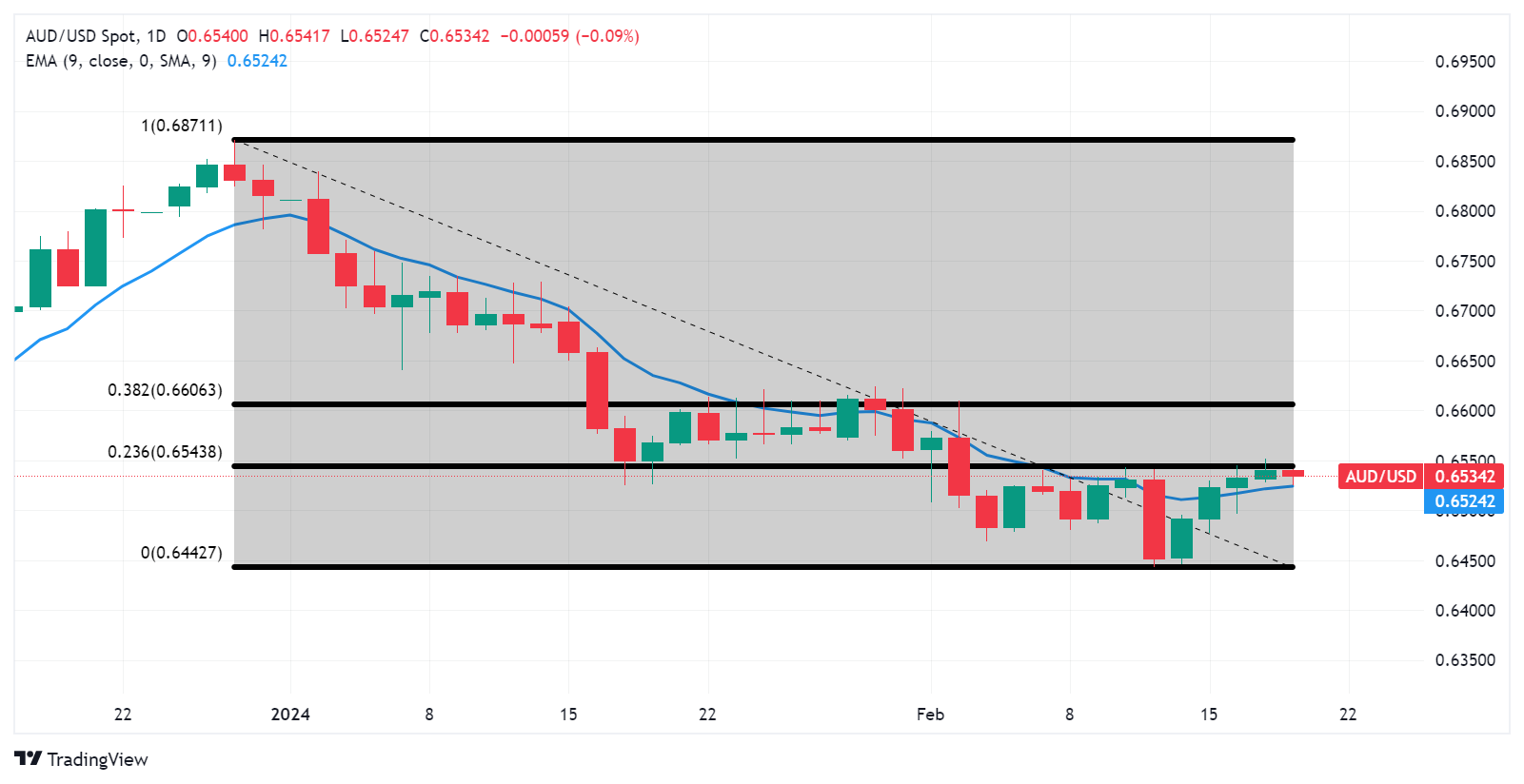- Australian Dollar extends its winning streak on a subdued US Dollar on Tuesday.
- Australia’s ASX 200 index moves lower and weighs on Aussie Dollar.
- PBoC maintains its one-year LPR at 3.45% but reduces the five-year LPR by 25 basis points.
- Greenback lost its daily gains due to the decline in the US Treasury yields.
The Australian Dollar (AUD) recovers its intraday losses and continues its winning streak for the fifth successive session on Tuesday as the US Dollar (USD) loses its daily gains on lower US Treasury yields. This is exerting upward support for the AUD/USD pair. However, the AUD faced downward pressure from a weaker Aussie money market. The S&P/ASX 200 index halted its winning streak, with mining and energy stocks declining amid weaker commodity prices.
Australian Dollar avoided reacting to the Reserve Bank of Australia’s (RBA) minutes from the February monetary policy meeting. The RBA Board discussed the possibility of hiking rates by 25 basis points (bps) or maintaining the status quo. While data provided the board with more confidence that inflation would return to target within a reasonable timeframe, it was noted that it would "take some time" before the board could be sufficiently confident about inflation. Therefore, the board agreed that it was appropriate not to rule out another rate hike.
The US Dollar Index (DXY) edges lower as the market returns from a holiday-extended weekend, with investors eagerly anticipating the release of the US Federal Open Market Committee (FOMC) Minutes scheduled for Wednesday. ANZ anticipates that the Federal Reserve (Fed) will commence rate cuts from July 2024. According to the CME FedWatch Tool, there is approximately a 53% probability of a 25 basis points rate cut by the US Fed in the June meeting.
Daily Digest Market Movers: Australian Dollar appreciates on subdued US Dollar
- The ANZ-Roy Morgan Consumer Confidence improved to 82.8 this week from 82.6 prior. Remarkably, the index has now spent a record 55 consecutive weeks below the mark of 85.
- Westpac expects a resilient Australian economy supported by low unemployment and healthy corporate sector balance sheets. Westpac anticipates the RBA will maintain its current monetary policy stance throughout 2024 and adopt a less restrictive approach in 2025.
- The People’s Bank of China (PBoC) decided to maintain its one-year Loan Prime Rate (LPR) at 3.45%. Additionally, the PBoC reduced the five-year LPR by 25 basis points from 4.20% to 3.95%.
- Premier of the People's Republic of China, Li Qiang, emphasized the importance of maintaining consistent and stable policies. The PBoC opted to keep its Medium-term Lending Facility (MLF) rate unchanged at 2.5%.
- The Federal Reserve's dot plot for this year indicates an expectation of 75 basis points in rate cuts, whereas the Fed funds futures market is pricing in approximately 89 basis points in cuts.
- San Francisco Federal Reserve President Mary C. Daly addressed the Annual National Association for Business Economics (NABE) Policy Conference, where she mentioned that three rate cuts are a reasonable baseline for 2024. Daly emphasized that it's premature to consider allowing the economy to run without intervention.
- St. Louis Federal Reserve (Fed) president, James Bullard suggested at the NABE conference that the Federal Reserve should consider lowering interest rates at its March meeting to avoid dampening economic activity due to higher rates.
- The preliminary Michigan Consumer Sentiment Index improved to 79.6 from 79.0 prior, lower than the expected reading of 80.0.
- The US Core Producer Price Index (YoY) improved by 2% in January, surpassing the expected 1.6% and 1.7% prior. The MoM data showed a rise of 0.5%, against the expected 0.1% improvement from the previous decline of 0.1%.
- US Producer Price Index came in at 0.9% year-over-year compared to the anticipated 0.6% and previous growth of 1.0%. Meanwhile, monthly improvement was 0.3% against the previous decline of 0.1%.
- US Building Permits (MoM) contracted to 1.470 million in January, against the expected rise to 1.509 million from the previous 1.493 million.
Technical Analysis: Australian Dollar breaks above the major support of 0.6550
The Australian Dollar traded near 0.6530 on Tuesday, positioned above the immediate support around the nine-day Exponential Moving Average (EMA) at 0.6523 followed by the psychological support level of 0.6500. On the upside, the AUD/USD pair could find the key resistance zone around the 23.6% Fibonacci retracement at 0.6543 and the major level of 0.6550. A breakthrough above this zone could lead the AUD/USD pair to approach the psychological barrier of 0.6600 before the 38.2% Fibonacci retracement level of 0.6606.
AUD/USD: Daily Chart
Australian Dollar price today
The table below shows the percentage change of Australian Dollar (AUD) against listed major currencies today. Australian Dollar was the strongest against the US Dollar.
| USD | EUR | GBP | CAD | AUD | JPY | NZD | CHF | |
| USD | -0.25% | -0.11% | -0.18% | -0.48% | -0.07% | -0.50% | -0.12% | |
| EUR | 0.24% | 0.13% | 0.07% | -0.24% | 0.17% | -0.25% | 0.13% | |
| GBP | 0.12% | -0.13% | -0.06% | -0.36% | 0.05% | -0.38% | 0.00% | |
| CAD | 0.18% | -0.11% | 0.05% | -0.30% | 0.12% | -0.33% | 0.06% | |
| AUD | 0.52% | 0.27% | 0.38% | 0.34% | 0.44% | -0.06% | 0.40% | |
| JPY | 0.08% | -0.16% | -0.04% | -0.09% | -0.43% | -0.44% | -0.05% | |
| NZD | 0.50% | 0.26% | 0.39% | 0.33% | 0.02% | 0.43% | 0.38% | |
| CHF | 0.13% | -0.12% | 0.01% | -0.05% | -0.36% | 0.06% | -0.38% |
The heat map shows percentage changes of major currencies against each other. The base currency is picked from the left column, while the quote currency is picked from the top row. For example, if you pick the Euro from the left column and move along the horizontal line to the Japanese Yen, the percentage change displayed in the box will represent EUR (base)/JPY (quote).
Australian Dollar FAQs
What key factors drive the Australian Dollar?
One of the most significant factors for the Australian Dollar (AUD) is the level of interest rates set by the Reserve Bank of Australia (RBA). Because Australia is a resource-rich country another key driver is the price of its biggest export, Iron Ore. The health of the Chinese economy, its largest trading partner, is a factor, as well as inflation in Australia, its growth rate and Trade Balance. Market sentiment – whether investors are taking on more risky assets (risk-on) or seeking safe-havens (risk-off) – is also a factor, with risk-on positive for AUD.
How do the decisions of the Reserve Bank of Australia impact the Australian Dollar?
The Reserve Bank of Australia (RBA) influences the Australian Dollar (AUD) by setting the level of interest rates that Australian banks can lend to each other. This influences the level of interest rates in the economy as a whole. The main goal of the RBA is to maintain a stable inflation rate of 2-3% by adjusting interest rates up or down. Relatively high interest rates compared to other major central banks support the AUD, and the opposite for relatively low. The RBA can also use quantitative easing and tightening to influence credit conditions, with the former AUD-negative and the latter AUD-positive.
How does the health of the Chinese Economy impact the Australian Dollar?
China is Australia’s largest trading partner so the health of the Chinese economy is a major influence on the value of the Australian Dollar (AUD). When the Chinese economy is doing well it purchases more raw materials, goods and services from Australia, lifting demand for the AUD, and pushing up its value. The opposite is the case when the Chinese economy is not growing as fast as expected. Positive or negative surprises in Chinese growth data, therefore, often have a direct impact on the Australian Dollar and its pairs.
How does the price of Iron Ore impact the Australian Dollar?
Iron Ore is Australia’s largest export, accounting for $118 billion a year according to data from 2021, with China as its primary destination. The price of Iron Ore, therefore, can be a driver of the Australian Dollar. Generally, if the price of Iron Ore rises, AUD also goes up, as aggregate demand for the currency increases. The opposite is the case if the price of Iron Ore falls. Higher Iron Ore prices also tend to result in a greater likelihood of a positive Trade Balance for Australia, which is also positive of the AUD.
How does the Trade Balance impact the Australian Dollar?
The Trade Balance, which is the difference between what a country earns from its exports versus what it pays for its imports, is another factor that can influence the value of the Australian Dollar. If Australia produces highly sought after exports, then its currency will gain in value purely from the surplus demand created from foreign buyers seeking to purchase its exports versus what it spends to purchase imports. Therefore, a positive net Trade Balance strengthens the AUD, with the opposite effect if the Trade Balance is negative.
Information on these pages contains forward-looking statements that involve risks and uncertainties. Markets and instruments profiled on this page are for informational purposes only and should not in any way come across as a recommendation to buy or sell in these assets. You should do your own thorough research before making any investment decisions. FXStreet does not in any way guarantee that this information is free from mistakes, errors, or material misstatements. It also does not guarantee that this information is of a timely nature. Investing in Open Markets involves a great deal of risk, including the loss of all or a portion of your investment, as well as emotional distress. All risks, losses and costs associated with investing, including total loss of principal, are your responsibility. The views and opinions expressed in this article are those of the authors and do not necessarily reflect the official policy or position of FXStreet nor its advertisers. The author will not be held responsible for information that is found at the end of links posted on this page.
If not otherwise explicitly mentioned in the body of the article, at the time of writing, the author has no position in any stock mentioned in this article and no business relationship with any company mentioned. The author has not received compensation for writing this article, other than from FXStreet.
FXStreet and the author do not provide personalized recommendations. The author makes no representations as to the accuracy, completeness, or suitability of this information. FXStreet and the author will not be liable for any errors, omissions or any losses, injuries or damages arising from this information and its display or use. Errors and omissions excepted.
The author and FXStreet are not registered investment advisors and nothing in this article is intended to be investment advice.
Recommended content
Editors’ Picks

EUR/USD trades deep in red below 1.0300 after strong US jobs report
EUR/USD stays under bearish pressure and trades below 1.0300 in the American session on Friday. The US Dollar benefits from the upbeat jobs report, which showed an increase of 256,000 in Nonfarm Payrolls, and forces the pair to stay on the back foot heading into the weekend.

GBP/USD drops toward 1.2200 on broad USD demand
GBP/USD extends its weekly slide and trades at its weakest level since November 2023 below 1.2250. The data from the US showed that Nonfarm Payrolls rose by 256,000 in December, fuelling a US Dollar rally and weighing on the pair.

Gold ignores upbeat US data, approaches $2,700
Following a drop toward $2,660 with the immediate reaction to strong US employment data for December, Gold regained its traction and climbed towards $2,700. The risk-averse market atmosphere seems to be supporting XAU/USD despite renewed USD strength.

Sui bulls eyes for a new all-time high of $6.35
Sui price recovers most of its weekly losses and trades around $5.06 at the time of writing on Friday. On-chain metrics hint at a rally ahead as SUI’s long-to-short ratio reaches the highest level in over a month, and open interest is also rising.

Think ahead: Mixed inflation data
Core CPI data from the US next week could ease concerns about prolonged elevated inflation while in Central and Eastern Europe, inflation readings look set to remain high.

Best Forex Brokers with Low Spreads
VERIFIED Low spreads are crucial for reducing trading costs. Explore top Forex brokers offering competitive spreads and high leverage. Compare options for EUR/USD, GBP/USD, USD/JPY, and Gold.
